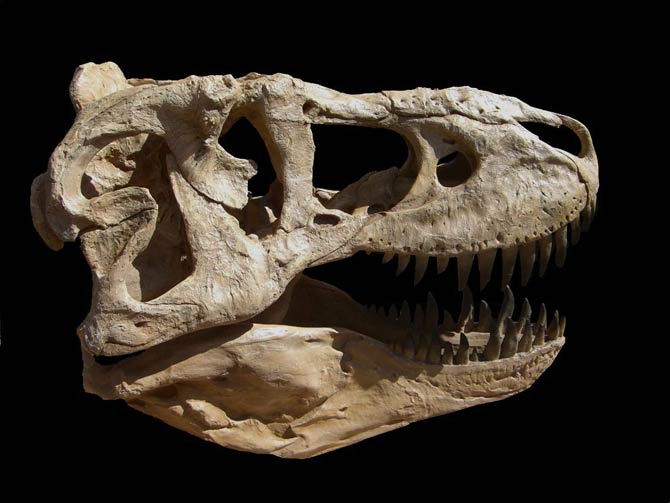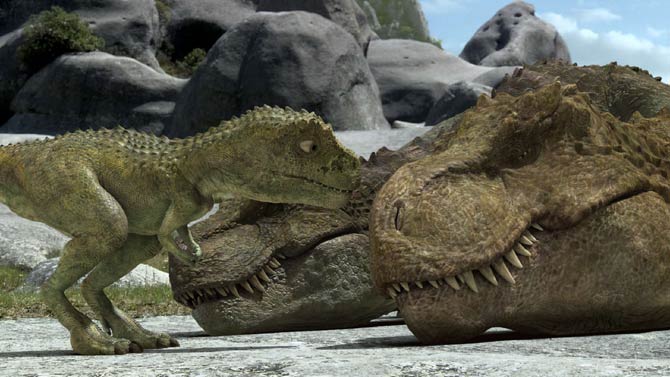Tarbosaurus bataar
Tarbosaurus bataar
Many species of this theropod have been classified over the years, but today only one is accepted. The Asian equivalent of T. rex – the king of the local forests and the terror of all animals with which it coexisted. Tarbosaurus and Tyrannosaurus are considered closely related, although some paleontologists consider the Alioramus, also from Mongolia, to be the closest relative of Tarbosaurus. So today, we are taking you on a trip to Asia to meet one of the most dangerous beasts of all time.
Classification
- Kingdom: Animalia
- Phylum: Chordata
- Clade: Dinosauria
- Clade: Saurischia
- Clade: Theropoda
- Family: †Tyrannosauridae
- Subfamily: †Tyrannosaurinae
- Genus: †Tarbosaurus
- Species: †Tarbosaurus bataar

Misspelled name
The word “tarbosaurus” translates to “alarming / terror / disturbing lizard”. The species member “bataar” is the result of an error (the name of Google, for example, is also such a curiosity), because the discoverer Evgeny Aleksandrovich Maleev (Евгений Александрович Малеев) made a mistake assuming that the Mongolian word “hero” is spelled “bataar”. However, the correct spelling is “baatar”. In paleontology, species names cannot be changed, irrespective of their mistakes, so the name Tarbosaurus bataar has remained.

Tarbosaurus’ occurrence and natural environment
The theropod with a structure very similar to the North American “tyrant” – T. rex – (both great reptiles were therefore present at the same time, but in different areas). It lived in Asia, and more precisely – today’s Mongolia, China and Korea, but the most bones were found in the Gobi Desert, in the Nemegt Formation. He lived about 70-65 million years ago, in the Late Cretaceous (Maastricht).
The Nemegt formation
The Nemegt Formation is rich in traces of river channels and soil sediments that indicate a much wetter climate than suggested by the two previously analyzed formations: Djadochta and Barun Goyot. However, the presence of sedimentary rock – clichés – in the Nemegt Formation indicates periodic droughts. The sediment was found in canals and floodplains of large rivers.
In the described formation, fossils of mollusks, fish, turtles and crocodiles were also found, including the species Shamosuchus, whose teeth were adapted to chewing hard shells.
Mammal remains in the Nemegt Formation are extremely rare, but many birds remain from the clades Enantiornithes, Hesperornithes, and Judinornis, as well as the Teviornis bird (an early representative of waterfowl), have been discovered.
In addition to birds, many dinosaurs have also been discovered: Ankylosaurus, Pachycephalosaurus, Prenocephalus.
The largest predator of those areas was precisely the Tarbosaurus, which most likely hunted large hadrosaurs: Saurolophus and Barsboldia, as well as sauropods: Opisthocoelicaudia skarzynskii or Nemegtosaurus mongoliensis. It is possible that – similar to the young Komodo dragons – young and immature Tarbosaurs filled the ecological niche between huge adults and other small theropods.

Discovery
In 1946, a Soviet-Mongolian expedition of paleontologists to the Gobi Desert resulted in the discovery of a skull and several vertebrae of a previously unknown theropod in the Nemegt Formation. In 1965, Anatoly Konstantinovich Rozhdestvensky recognized the discovered theropods as a species separate from the North American tyrannosaur. He named it Tarbosaurus bataar to include all individuals from 1955 and new finds. Originally, this dinosaur was classified by his discoverer (Evgeny Aleksandrovich Maleev) incorrectly as Tyrannosaurus bataar.
In 1963, the excavations were continued by a Polish-Mongolian team, whose work was completed in 1971, finding many new Tarbosaurus remains at that time. Kenneth Carpenter – an American paleontologist – analyzed material from the Nemegt Formation in 1992. He concluded that the dinosaur he found belongs to the genus Tyrannosaurus.
All studies published up to 1999 concluded that the remains belong to one species referred to as Tarbosaurus bataar or Tyrannosaurus bataar.
Expeditions with the participation of Japanese and Mongolian scientists between 1993 and 1998 and private expeditions organized by Canadian paleontologist Phil Currie, at the beginning of the 21st century, resulted in the discovery of further elements of the Asian theropod’s skeleton. Thanks to all the expeditions, 15 skulls and several complete skeletons were found. Nowadays, more than 30 specimens can be seen in museums.

Characteristic
Tarbosaurus was a large carnivorous theropod dinosaur found in Mongolia. Like its close North American relative Tyrannosaurus rex, it had a very large head and strong jaws, but it was not one of the heaviest theropods. Its huge skull was relatively thin and light, with large hollow holes. Many of his bones were hollow – but they were strong, but light, thanks to which this huge predator was not overweight and was more agile and faster than theropods previously found on Earth (such as Giganotosaurus or Carcharodontosaurus.
Tarbosaurus is one of the best-known theropods and dinosaurs in general, weighing approx. 6 tons and measuring approx. 10-12 m in length. He lived in humid floodplains. In his environment, he was undoubtedly the apex predator at the top of the food chain.
Its jaw was equipped with 60 powerful teeth. It had a unique jaw locking mechanism and the smallest of the tyrannosaurs, two-finger forelegs.

Front limbs
Like all tyrannosaurs, Tarbosaurus had very short arms – so short they could not even reach mouths. This feature has caused paleontologists for many years to be surprised, but it makes the phrase “if you don’t use something, you might lose it” makes more sense.
Forgive the digression – in our opinion many people should take this saying deeply to heart – especially politicians – in the context of the reason (brain) 😉

The way of hunting
Many smaller theropods have focused on prey of various sizes, tyrannosaurs have focused mainly on the largest ones! They were able to defeat their victims with the help of their huge jaws, teeth and neck muscles.
Let’s imagine a giant cleaver mounted on an incredibly muscular neck, acting as a 6-ton battering ram.
The method of attack adopted by tyrannosaurs often boiled down to tearing out a huge lobe of the victim’s muscles, and the Tarbosaurus waited, letting its victim die of blood loss.

Tarbosaurus vs T. rex (Tyrannosaurus rex)
Although it was slightly smaller than the T. rex, it still belonged to the group of the largest tyrannosaurs. His skull was best known, measuring over 1.3 m (4.3 ft). The skull was tall, but not as wide as that of the T. rex, especially at the back.
The arrangement of the eye sockets indicates that he did not have a stereoscopic (binocular) vision, which – in other tyrannosaurs – was a common phenomenon.
Skull
Large windows (holes) in the skull reduced the body weight. It had slightly more teeth than the other theropods from the Tyrannosaurus family. The teeth were oval in cross section, but the upper jaw cheek teeth had a “D” shaped section. The longest teeth were approx. 8.5 cm (3.3 in).
Tyrannosaurs were not very diverse in their structure – Tarbosaurus was no exception.
The head was mounted on a neck bent in the shape of the letter “S”. The rest of the spine, including the long tail, was horizontal. The small forelimbs did not play a more important role, while the hind limbs were powerful, massive and long. The heavy body rested on them. The tail was also distinguished by massiveness and length – it served as a counterweight to the head and torso, and the center of gravity was located on the hips.

Differences in construction
The skull of a Tarbosaurus was first described in 2003. Scientists have noticed many differences in structure between the Asian and North American tyrannosaurs. Many of these differences are due to the load on the bones when bitten. Moreover, the mandible of Tarbosaurus was found to be quite stiff, while many North American theropods (especially tyrannosaurs) had quite flexible mandibles.
Scientists hypothesized that the stiffer jaw (and the entire skull) of a Tarbosaurus was adapted to the hunt for the mighty titanosaur sauropods, the remains of which were also found in the Nemegt Formation. Upon analysis of the skull, it was concluded that the Tarbosaurus had a very good sense of smell (the same was true for T. rex – see T.rex myths and facts). It probably had a well-developed Jacobson’s organ (vomeronasal organ (VNO)) responsible for pheromone detection.
The number of teeth in the found skulls ranges from 58 to 64. This is slightly more than in the T.rex, but less than, for example, a slightly smaller reptile from the tyrannosaur family – Gorgosaurus.

Broken bones
Although tyrannosaurs were hunters, life did not spoil them. Many of the skeletons found have broken bones that were healed during the animals’ lifetime. This indicates both injuries sustained during hunting and during mutual fights.
Who was bigger: Tarbosaurus or T. rex?
The largest complete Tyrannosaurus rex skeleton found is 12.3 meters (40.35 ft ) long [14-15 meters (46 – 49 ft) UCMP 118742 and UCMP 137538 are unconfirmed, while the largest Tarbosaurus is 12 meters (39.4 ft). However, there is always a chance to find larger specimens for both types. Therefore, it is difficult to say which one was bigger.

Detailed data and dimensions (size)
Tarbosaurus (Tarbosaurus bataar)
Dimensions
- Length: 10 – 12 m (32.8 – 39.4 ft) / 10.6 m (34.8 ft) year 2020
- Height (from the ground to the hip): 3.35 m (11 ft)
- Weight: 3 – 6 t / 5 t (year 2020)
Occurrence
- The areas of today’s Korea, China, Mongolia (Gobi Desert)
- Dating: 72 – 66 million years ago
- Temporal range: Late Cretaceous – Maastrichtian
Discovery
- Asia (Mongolia)
- Discovered: 1955
- Discoverer: Yevgeny Aleksandrovich Malejew
- Described: 1965
In 2003, a detailed analysis confirmed that Tarbosaurus and T.rex (Tyrannosaurus rex) are two different species.

Tarbosaurus – interesting facts
- The brain of Tarbosaurus looked more like that of a crocodile than that of a bird.
- The pressing force of the Tarbosaurus jaws was about 7 tons (see T. rex myths and facts).
- Tarbosaurus fossils are only found in the Gobi Desert (Mongolia and China), from where they are banned from being exported, but some remains have been looted anyway by private collectors.
- The total brain volume of a 12-meter individual was estimated to be only 184 cm3. For comparison, the volume of the human brain is 1053-1499 cm3.
- The similarity between the Tarbosaurus and T. rex can be related only to similar dimensions, which were the result of the so-called convergent evolution.
- Tarbosaurus bones and casts of its skeleton are also exhibited in Poland by the Museum of Evolution of the Polish Academy of Sciences in Warsaw.

Recommended
- The longest dinosaurs. Sauropods Top 10
- The heaviest dinosaurs – Top 10
- The longest predatory dinosaurs. Theropods Top 10
- The heaviest predatory dinosaurs Top 10
- The longest Ornithischians (Ornithischia) TOP 10
- The heaviest Ornithischians Top 10
- The largest raptors (dromaeosaurs) Top 10
- The heaviest Dromaeosaurids / dromaeosaurs – Top 10
- The longest Ankylosaurus Top 10
- The heaviest Ankylosaurus Top 10
- The longest ceratopsians
- The heaviest cerapsians
- The longest and largest ornithopods
- The heaviest ornithopods Top 10
- The longest Stegosaurians (Stegosauria) TOP 10
- The heaviest Stegosaurians (Stegosauria) Top 10
- The smallest sauropods Top 10
- The smallest dinosaurs Top 10
- The largest pterosaurs Top 10
- Dinosaurs
- Dinosaurs database
- Predatory dinosaurs
- Animals & dinosaurs records
- The fastest animals – Top 100
- The fastest birds – Top 10


















